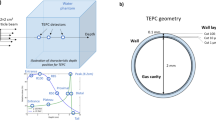Abstract
The introduction in the 1950s of 60Co teletherapy units and megavoltage X-ray accelerators for radiotherapy prompted several studies which showed that the relative biological effectiveness (RBE) of orthovoltage X rays, compared with 60Co γ rays, was ∼1.1–1.2 (refs 1, 2). Subsequently, radiation therapists confirmed that the effect of established treatment protocols using orthovoltage X rays could be duplicated with the higher energy radiation by increasing the dose by ∼10%, when radiation doses are of the order of tens of grays (or thousands of rads). The dependence of biological effectiveness on photon energy led to recommendations in which the quality factor, Q, which is an RBE for radiation protection purposes, was set at unity for X and γ rays as well as for electrons or other directly ionizing particles having a linear energy transfer (LET) of <3.5 keV µm−1. Over the past decade, however, several studies have shown differences in RBE between various low-LET radiations having LET values within the range designated for standard radiation3–6. Underbrink et al.7 found an RBE for orthovoltage X rays relative to 60Co γ rays of ∼2 at 0.04 Gy, for induction of pink mutations in the stamen hairs of Tradescantia. Schmidt et al.8 scored chromosome aberrations in human lymphocytes, and at 0.25 Gy found the RBE of 200-kVp X rays relative to 3-MeV electrons to be also ∼2. Here we have compared 60Co γ rays and orthovoltage X rays over the dose range 0.03–1.5 Gy using malignant transformation in mammalian cells in vitro9–13 as an end point. Our findings indicate that whereas the transformation incidence seems similar for X and γ rays at high doses, the malignant potential of X rays is about twice that of γ rays at 0.03 Gy.
This is a preview of subscription content, access via your institution
Access options
Subscribe to this journal
Receive 51 print issues and online access
$199.00 per year
only $3.90 per issue
Buy this article
- Purchase on Springer Link
- Instant access to full article PDF
Prices may be subject to local taxes which are calculated during checkout
Similar content being viewed by others
References
Hall, E. J. Br. J. Radiol. 34, 313 (1961).
Sinclair, W. Radiat. Res. 16, 394 (1965).
Lloyd, D. C. et al. Int. J. Radiat. Biol. 28, 75–90 (1975).
Virsik, R. P. & Harder, D. Radiat. envir. Biophys 14, 109–121 (1977).
Zeitz, L., Kim, S. H., Kim, J. H. & Detko, J. F. Radiat. Res. 70, 552–563 (1977).
Berry, R. J., Cavanagh, J., Oliver, R. & Winston, B. M. Hlth Phys. 24, 369–374 (1973).
Underbrink, A., Kellerer, A., Mills, R. & Sparrow, A. Radiat. envir. Biophys. 13, 295 (1976).
Schmidt, E., Rimpl, G. & Bauchinger, M., Radiat. Res. 57, 228 (1974).
Borek, C. & Sachs, L. Nature 210, 276–278 (1966).
Borek, C. & Hall, E. J. Nature 243, 450–453 (1973).
Borek, C. & Hall, E. J. Nature 252, 499–501 (1974).
Borek, C., Hall, E. J. & Rossi, H. H. Cancer Res. 38, 2997–3005 (1978).
Han, A. & Elkind, M. J. Cancer Res. 39, 123–130 (1979).
Bond, V. P., Meinhold, C. B. & Rossi, H. H. Hlth Phys. 34, 433–438 (1978).
Arnett, L. M. Rep. DP-1416, Savannah River Laboratory, DuPont, Aiken, South Carolina, 1–19 (1976).
Author information
Authors and Affiliations
Rights and permissions
About this article
Cite this article
Borek, C., Hall, E. & Zaider, M. X rays may be twice as potent as γ rays for malignant transformation at low doses. Nature 301, 156–158 (1983). https://doi.org/10.1038/301156a0
Received:
Accepted:
Issue Date:
DOI: https://doi.org/10.1038/301156a0
This article is cited by
-
Dose assessment for daily cone-beam CT in lung radiotherapy patients and its combination with treatment planning
Physical and Engineering Sciences in Medicine (2022)
Comments
By submitting a comment you agree to abide by our Terms and Community Guidelines. If you find something abusive or that does not comply with our terms or guidelines please flag it as inappropriate.



